
Historic $10 Million Gift Will Transform the Charles E. Smith Center | Two Projects Aim to Improve Global Health | Noted Alumni Inducted into Sports Executives Hall of Fame
| Gala Raises Funds for Cancer Programs | Joe McKeown: GW’s Winningest Coach | Above the Rim
| $2.5 Million Gift Creates an Endowed Professorship in Hebrew Bible | GW Inaugurates Nationals Park With a Win | GW Invests in Research
| Faculty Focus | George Welcomes | New Technology Allows Rapid Cell Analysis | Students Branch Out With Eco Project | Two Discoveries Explain Scientific Remains | Rural Culture on the Edge | GW Launches Five-Year Plan to Address Affordability | At A Glance | A Faculty for Writing

Historic $10 Million Gift Will Transform the Charles E. Smith Center
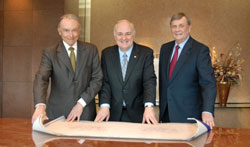
Robert H. Smith, GW President Steven Knapp, and Robert P. Kogod
Julie Woodford
President Steven Knapp in February announced the largest single donation in the institution’s history—a $10 million gift toward the renovation of the Charles E. Smith Center from the Robert H. Smith and Charles E. Smith Family Foundations and Robert and Arlene Kogod. This lead gift will be instrumental in the renovation of the 32-year-old building, located in the heart of GW’s Foggy Bottom campus.
The University plans to raise an additional $15 million for the renovation. The first $10 million of this goal will meet the one-to-one challenge that is a condition of the Smith-Kogod families’ commitment and is designed to encourage others to support this important project.
“The Charles E. Smith Center has always been a source of pride to our family because it promotes healthy minds and bodies, as well as the spirit of community, which were hallmarks of my father’s life and work,” says Robert H. Smith, a GW trustee emeritus and chairman of several Charles E. Smith real estate companies. “This transformational renovation of the Charles E. Smith Center will create a signature building, in both its architecture and function, in the heart of the GW campus. It furthers my father’s original vision and speaks to our commitment to GW and its future success.”
The proposed renovation will take place generally within the building’s existing structure. The University will soon present architectural concepts to GW and community stakeholders and then coordinate reviews and approvals with the appropriate District of Columbia agencies.
“I am deeply appreciative of the Smith and Kogod families for this historic gift to the University,” GW President Steven Knapp says. “Their leadership sets a new standard for us and further recognizes the need for world-class facilities at a world-class university. The convergence of academic, athletic, and recreational components in the transformed Charles E. Smith Center will provide a premier venue for our student-athletes that also will support their academic pursuits. Combined with other uses, the renewed Charles E. Smith Center will enhance the overall GW experience for our entire community.”
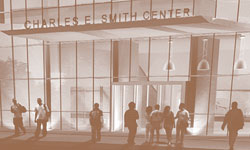
The renovated Charles E. Smith Center will be the signature building in the heart of the Foggy Bottom Campus.
Rendering by GenslerW. Russell Ramsey, BBA ’81, chairman of GW’s Board of Trustees, adds, “This shining example of our new culture of philanthropy will benefit our faculty, students, alumni, and the community. I salute the Smith and Kogod families for this latest substantial investment in our University’s future. And I congratulate President Knapp who, within six months of his arrival, has now secured the largest single gift in the history of the institution. Combined with our commitment to affordability, our increased investment in research, and our overall campus plan, we are now out of the starting gate and gaining true momentum. It’s a great beginning for the new administration and a tribute to one of GW’s most important and beloved families.”
The facility was named for the late Charles E. Smith, a renowned real estate developer, philanthropist, community leader, and recipient of an Honorary Doctor of Public Service degree from GW in 1979. His son, Robert H. Smith, is married to Clarice Rae Smith, BA ’76, MFA ’79. Their son, David Bruce Smith, BA ’79, has been a member of GW’s Board of Trustees since 2002. Robert P. Kogod, a longtime friend of the University, is married to Arlene R. Kogod, the daughter of Charles E. Smith.
Interior upgrades to the Charles E. Smith Center will feature an academic center for student-athletes, improved general admission and club seating in the basketball arena, new locker rooms, remodeled office space to centralize athletic operations including those currently located elsewhere on campus, enhanced athletic training and weight room facilities, and a renovated natatorium.
The exterior concepts include a dynamic new main entrance along 22nd Street, which will present a revitalized box office and concession concourse, and a new VIP entrance along F Street. The project is consistent with the 2007 Foggy Bottom Campus Plan and reinforces 22nd Street as the core of the campus. The renovation project is expected to take three years, during which time the building will remain open without interruption of planned events.

Two Projects Aim to Improve Global Health
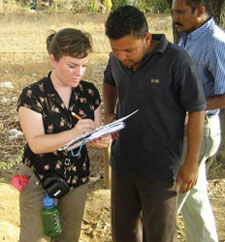
Elizabeth Collins, MPH ’05, signs up community volunteers to do manual labor for the potable water system in Santa Clara, El Salvador. GW alumna Elizabeth Collins is using her public health know-how to help improve the wellness of a Central American community.
Collins, MPH ’05, has organized a comprehensive project with GW students and partners to install a potable water system for the 3,000-person town of Santa Clara, El Salvador, while also educating the community about proper hygiene and effective sanitation.
This spring, she and her team, which includes GW students, as well as representatives from the D.C. chapter of Engineers Without Borders, Peace Corps, Salvadoran nongovernmental organizations, Catholic University of America, Rotary Club of Glen Burnie, and the Salvadoran Ministry of Health, are working with the Santa Clara community to construct and install a potable water system, including a pump, tank, and chlorination system that distributes running water to households in the town.
It should take two months for community volunteers to dig trenches and lay pipes, followed by two months of construction for the $300,000 project, with about $50,000 worth of manual labor and supplies donated by the Santa Clara community. GW students are working to create a detailed training manual for health promoters who will continue to monitor hygiene practices in Santa Clara. When both parts of the project are completed, Collins says there will be an 18-month pilot program monitoring the effectiveness of the project in improving health.
Collins was first drawn to El Salvador in 2004, when she visited Santa Clara as part of her research for her master’s thesis in public health. Her friend, Yanira Cruz, MPH ’94, DrPH ’07, has family there and had told Collins about the town’s health needs. While visiting, Collins discovered that some people spent hours a day getting water from contaminated wells and that a major priority was access to potable water.
The next year, a small group of GW students returned to conduct an in-depth water assessment. Collins says more than 20 GW students have been involved with the project since its inception.
While working in Santa Clara, the team identified other important needs. “The next urgent health issue to be addressed is respiratory illness,” Collins says. Residents there use open cooking fires, so Collins, who plans to begin her doctorate in public health this fall in the department of prevention and community health, hopes to implement a clean burning stove project in the community.
Training Doctors in Africa
Eritrea, a sub-Saharan African country a little larger than Pennsylvania, has only five pediatricians, four obstetricians, and seven surgeons serving a population of nearly 4.9 million people. With limited resources, the remaining general practitioners often are called on to perform surgeries and pediatric duties. Faced with this challenge, the Eritrean Minister of Health, Saleh Meky, has waged a battle against the health care limits of the country, and GW Medical Center is poised to help.
In a partnership with the GW Medical Center, Children’s National Medical Center, Physicians for Peace, and the Eritrean Ministry of Health/Orotta School of Medicine, U.S.-educated surgeons, pediatricians, and physicians are helping to train Eritrean specialist physicians in a new program that aims to build a sustainable health care infrastructure and become a model resource for other developing countries.
The first “class” of pediatric residents includes seven Eritrean general practitioners, each with between six and 10 years of general practice experience.
“We will need existing faculty members, GW alumni, and other specialists to fill this need in training surgeons as well as pediatricians,” says Huda Ayas, executive director of GW’s Office of International Medicine Programs. She says that Physicians for Peace will provide initial resources to support the training but acknowledged that the program’s financial needs are still great. For more information, contact Ayas at imphma@gwumc.edu or call 202-994-2796.
—Linda Dent and Allison Huggins
Noted Alumni Inducted into Sports Executives Hall of Fame
Two of the sports industry’s most prominent executives—David Falk, JD ’75, professional sports agent and founder/CEO of F.A.M.E.; and Jerry Reinsdorf, BA ’57, chairman of the Chicago Bulls and Chicago White Sox—were recently inducted into The GW School of Business Sports Executives Hall of Fame.
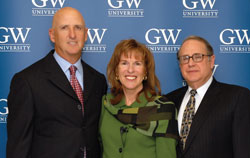 Professional sports agent and founder/CEO of F.A.M.E. David Falk, JD ’75 (left), and Chicago Bulls and Chicago White Sox Chairman Jerry Reinsdorf, BA ’57 (right), were inducted into the GW School of Business Sports Executives Hall of Fame earlier this year. They are shown here with GW Sports Management Program Director Lisa Delpy Neirotti.
The induction followed a panel discussion at the Jack Morton Auditorium on the topic of “Sports Powerbrokers: How Teams, Agents, and Athletes Score the Win-Win.” GW Board of Trustees Chairman W. Russell Ramsey, BBA ’81, and President Steven Knapp were among the students, faculty members, and alumni gathered for the discussion and induction ceremony.
Falk has represented more NBA first-round draft selections, lottery picks, rookies-of-the-year, and all-stars than any other agent in the athlete management business. He is credited with revolutionizing the NBA’s salary structure in the mid-1990s and has crafted some of the most successful athlete endorsement deals of all time, including the partnership between Michael Jordan and Nike.
Reinsdorf has helped capture a combined seven world championships for Chicago as the chairman of both the White Sox and the Bulls. He was instrumental in the construction of two new sports facilities in Chicago—Comiskey Park in 1991 (now U.S. Cellular Field) and the United Center in 1994. |
Gala Raises Funds for Cancer Programs
The 5th annual George Washington University Cancer Institute Gala, supported by principal benefactors Dr. and Mrs. Cyrus Katzen and Dr. and Mrs. Bernard Katzen, was held Saturday, May 3, at the National Building Museum. Proceeds from the black-tie event provide funds for critical cancer programs in the D.C. area. GW President Steven Knapp joined Provost and Vice President for Health Affairs John F. Williams in co-hosting the event, with Diane Robinson Knapp and Kimberly D. Russo, associate administrator at GW Hospital, serving as the gala co-chairs.
This year’s honorees were: Archbishop Emeritus Desmond Tutu, cancer survivor and recipient of the Nobel Peace Prize; Margaret Foti, PhD, CEO of the American Association for Cancer Research; Sean Swarner, two-time cancer survivor and founder of the CancerClimber Association; and Robert Siegel, MD, GW director of Hematology and Oncology, and Paula Siegel, RN.
NBC4 news anchor and health reporter Doreen Gentzler served as emcee of the event, which included a silent auction and entertainment by Grammy-nominated singer and songwriter Oleta Adams. For more information, visit www.gwcancer.org.

Joe McKeown: GW’s Winningest Coach
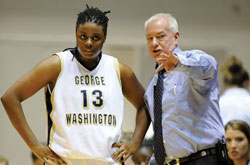
GW women’s basketball coach of 19 years Joe McKeown, pictured here with junior Antelia Parrish, reached a milestone 500 career wins this season.
GW Athletics CommuncationsWhen Colonials women’s basketball coach Joe McKeown arrived at GW in 1989, he never dreamed he’d become the winningest coach in University history. The much-loved skipper was honored Feb. 10 at the Charles E. Smith Center with a game ball and special halftime video tribute for securing his 500th career victory on Feb. 2.
During his 19 years at GW, McKeown has transformed the women’s basketball program, leading the team to 19 winning seasons and 14 NCAA tournament berths. A five-time Atlantic-10 coach of the year, McKeown is the 34th Division I women’s basketball coach to win 500 games.
While he is thrilled to have reached the coveted milestone, he acknowledges that he has been too busy to dwell on it. “I think that at the end of the year, my wife, Laura—who has been with me through this entire journey—and I will finally have the chance to sit back and think about all the great players and great moments we’ve had over the years that led us to this point.”
A native of Philadelphia, McKeown grew up entranced by basketball. “There were a lot of great coaches in Philadelphia at both the pro level and the Big Five colleges back in the ’60s and ’70s, so as a kid, I used to ride the subway down to the Palestra for all the games. It got me hooked on coaching.”
After playing college basketball at Kent State, McKeown was appointed assistant coach of the university’s women’s basketball team. He coached there for one year, simultaneously earning a master’s degree in athletic administration. At age 23, he landed his first head-coaching job at Burlington County College in New Jersey.
He made his first two trips to the NCAA Tournament as coach of New Mexico State from 1986 to 1989, winning 68 games in three seasons and ranking in the top 25 nationally. GW then came calling.
McKeown proudly states that his family is a GW family through and through. “My wife, Laura, is a GW alum with a degree in special education and all three of our children were born at GW Hospital,” he says. The McKeowns have been a fixture at GW games, both home and away. “When our oldest daughter Meghan was 2 weeks old, we put her on a plane and took her with us to a Colonials game in Las Vegas, and she’s been coming with us ever since,” McKeown says. Meghan, now 16, plays high school basketball for Flint Hill in Virginia and still attends most GW home games, along with McKeown’s wife, son Joey, 13, and daughter, Ally, 5.
He reveals that it’s a bit trickier now for the family to travel with the team to away games, as Joey has autism. “It’s our greatest challenge,” says McKeown, who is active in raising money for autism research.
Over the years, he has changed as a coach, but his love for the job has never faded. “When I was a younger coach, I was really into strategy and the technical part of the game and tried to be an innovator,” McKeown recalls. “As I got older, I became more involved with the players and with helping them improve and prepare for the real world. I take pride in helping my players be the best they can be.”
He loves when Colonials alumni come back to campus to share their successes. “We’ve been able to recruit some terrific student-athletes over the years, and seeing what they’ve done with their lives after GW is a bigger highlight for me than how many games we win,” he says. “Four have gone on to the WNBA, six or seven are doctors and lawyers, two are journalists.”
With his contract recently extended to June 2014, McKeown’s GW legacy undoubtedly will continue to grow. “I’m fortunate to coach at one of the premier universities in America,” he says. “Hopefully we’ll continue to turn out successful teams and graduate great players and make their lives better.”
—Jamie L. Freedman
Above the Rim
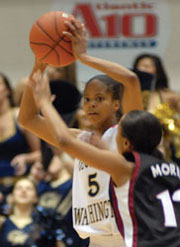
Kimberly Beck
GW's NCAA Tournament Sweet 16 this March. The Colonials, which had an impressive 27–7 overall record, also capped their year by ranking No. 14 in the final ESPN/USA Today Coaches’ Top 25 Poll. This is the third straight season that the team has been named in the Top 25: Last year, the team was ranked No. 11.
Team member and senior Kimberly Beck will continue her basketball career when she leaves GW this spring. Beck, a point guard who averaged career-highs of 12.5 points and 6.2 assists this season, was drafted in the third round by the WNBA’s Seattle Storm. Beck is the fourth player in GW women’s basketball history chosen in the WNBA draft and the first since 2004. Along with being named 2008 Atlantic 10 Player of the Year, Beck also was chosen as a first team All-Conference performer and a finalist for the Nancy Lieberman Award, which recognizes the nation’s top point guards. Beck finished her four-year career as GW’s all-time leader with 717 assists, and she ranks 12th in scoring with 1,395 points. |
$2.5 Million Gift Creates an Endowed Professorship in Hebrew Bible
A simple desire to help people of all religions better understand their common biblical roots was the motivating force behind Dr. Munr Kazmir’s $2.5 million gift to create an endowed professorship within the Judaic Studies program at GW’s Columbian College of Arts and Sciences.
“I wanted to fulfill a strategic opportunity within the program as well as build awareness that we are not as different as we seem,” explains Kazmir, a Pakistani immigrant who is of Jewish and Muslim descent. “This gift is from my heart.”
The Meir Kazmir, M.D., Professorship in Hebrew Bible, which uses the donor’s Hebrew name, will complement the University’s more than 25 years of scholarship in Judaic studies. GW plans to have a top scholar in place by the fall of 2009.
“This important gift supports the University’s commitment to the field of religious studies and the promotion of cross-cultural understanding,” GW President Steven Knapp says. “The new professorship will strengthen our interdisciplinary curriculum, and I am grateful to Dr. Kazmir for his foresight and generosity.”
The Kazmir Professorship is the first endowed chair to be announced since Steven Knapp became the University’s 16th president, and the second chair to be endowed in the Judaic Studies program. The Charles E. Smith Professorship of Judaic Studies was created in 1979.
Robert Eisen, director of the program in Judaic Studies and professor of religion at GW, describes the Hebrew Bible as the “foundational text for scholarship” in the Judeo-Christian canon. “The presence of a scholar engaged in the study of the Hebrew Bible will be a critical step in building a stronger Judaic Studies program at the University,” he adds.
Kazmir, whose daughter attends GW, is the CEO and founder of Direct Meds Inc., a prescription medicine provider, and Quality Home Care, which serves homeless, indigent, and child patients in the New York and New Jersey area. He also is CEO and president of the American International School System, a provider of high quality education for children in Asia and the Middle East, and is a board member on the National Advisory Council for the Agency for Healthcare Research and Quality. An internationally recognized philanthropist, Kazmir has received numerous humanitarian awards, including recognition from the Be’er Hagolah Institutes in 2005 and the Theodore Herzl Award in 1997 from the Israel Parliament, Prime Minister of Israel, and the Mayor of Jerusalem.
GW’s Judaic Studies program plays a critical role in helping students explore Judaism and Jewish culture. The program offers a well-rounded interdisciplinary curriculum in Jewish history, religion, literature, political science, and Hebrew language. It comprises faculty members who are internationally recognized scholars and enrolls hundreds of students annually.
“Judaism shares much with Christianity and Islam, two of the world’s major religions,” says Peg Barratt, dean of the Columbian College of Arts and Sciences and professor of psychology. “Dr. Kazmir’s generous gift will give GW another world-class faculty member who will enrich all aspects of our religious studies program.”
GW Inaugurates Nationals Park With a Win
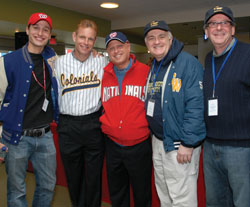
Above from left: GW student Jacob Lerner; Chairman of GW’s Board of Trustees W. Russell Ramsey, BBA ’81; Mark Lerner, BBA ’75; President Steven Knapp, and Senior Vice President of Student and Academic Support Services Robert Chernak. (Below): Sophomore Tom Zebroski.

This spring GW’s baseball team had a chance to experience
the “Big League” as it played the very first game at Nationals Park. The Colonials inaugurated the newly opened stadium in Southeast Washington with a 9–4 win over Saint Joseph’s University during a cool March 22 afternoon. Board of Trustees Chairman and former Colonials baseball player W. Russell Ramsey, BBA ’81, threw out the ceremonial first pitch while students and alumni cheered from their seats behind the Colonials dugout. The Atlantic 10-Conference game took place eight days before the Nationals’ official opener on March 30. The game marks the second time a GW team has participated in local stadium history. In 1961, GW’s football team hosted Virginia Military Institute in the dedication game of D.C. Stadium, now called RFK Stadium. |

GW Invests in Research
President Steven Knapp has announced the creation of a vice presidency for research at GW. The person selected through a nationwide search will serve as the University’s chief research officer and be charged with helping realize the research goals expressed in the University’s Strategic Plan for Academic Excellence, as well as the development of new initiatives.
Complementing the creation of this position is Knapp’s commitment to invest an additional $5.4 million over a three-year period beginning in July in GW’s internal research enterprise. These investments will be focused on improving the institution’s administrative infrastructure to aid faculty members in procuring external funding for research/scholarship, growing the University Facilitating Fund and the Research Enhancement Fund, and creating a special Chief Research Officer’s Startup Fund to help seed new research undertakings.
The new vice president will work closely with Donald R. Lehman, executive vice president for academic affairs, and John F. “Skip” Williams, provost and vice president for health affairs, to develop a strategic plan for research at GW that integrates both the nonmedical and medical areas. The central objective of such a plan will be to ensure the most effective and collaborative environment for faculty members and students in GW’s continuing development of cross-school research initiatives, especially those connected to interdisciplinary undertakings. In addition, the person will work closely with the chief academic operating officer of GW’s Virginia Campus in Ashburn, Va., in developing thriving research activity at that location, as well as work collaboratively with the deans of GW’s nine schools.

George Welcomes
 
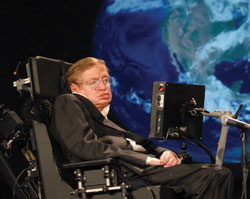
The Elliott School of International Affairs’ Space Policy Institute hosted a lecture by world-renowned physicist Stephen Hawking on “Why We Should Go into Space.” The April 21 discussion at the Jack Morton Auditorium was part of NASA’s 50th anniversary lecture series.
Jessica McConnell
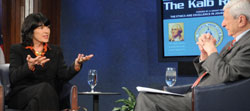
CNN Chief International Correspondent Christiane Amanpour offered an in-depth look at reporting on crisis and conflict during a standing-room-only March 10 program of GW’s Kalb Report at the National Press Club.
Jessica McConnell
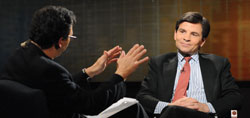
George Stephanopoulos, ABC News’ chief Washington correspondent and the host of ABC’s Sunday morning news show This Week, joined GW Professor Frank Sesno to discuss the 2008 political season, the media, and his personal journey through politics and journalism in front of a packed Jack Morton Auditorium audience on Feb. 12.
Jessica McConnell

Presidential candidate Sen. Hillary Clinton visited the University three times in less than a month. Here, she attends a rally and fundraiser at Lisner Auditorium after a foreign policy address earlier in the day on Feb. 25. On March 17, she came back to campus to give a major policy address about the war in Iraq.
Jessica McConnell
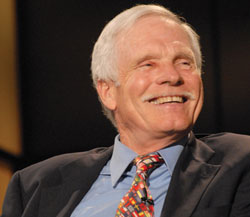
The Public Affairs Project at GW’s School of Media and Public Affairs, in conjunction with the University’s Elliott School of International Affairs, hosted a discussion between entrepreneur, environmentalist, humanitarian, and founder of CNN Ted Turner and GW professor Frank Sesno on April 9.
Jessica McConnell
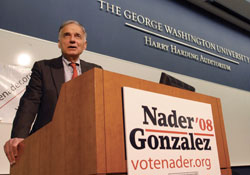
Independent presidential candidate Ralph Nader visited the Elliott School of International Affairs for his first campaign rally on March 3.
Abby Greenawalt
|
 |
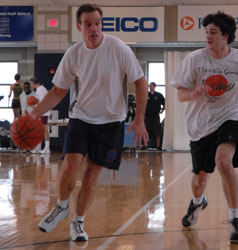
Each year since graduating from GW, former Virginia Gov. Mark Warner, BA ’77, and fellow alumni get together to shoot hoops. On Nov. 21, they played a game at GW’s Annette and Theodore Lerner Family Health and Wellness Center.
Jessica McConnell
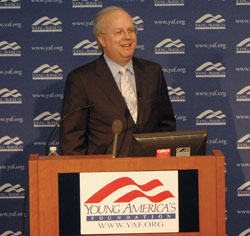
Former White House Deputy Chief of Staff Karl Rove spoke about his work in the George W. Bush administration and the 2008 presidential election during a March 28 event at the Elliott School of International Affairs. The lecture was sponsored by the student group Young America’s Foundation.
Nick Massella
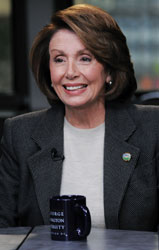
House Speaker Nancy Pelosi spoke with student media about the 2008 election and the war in Iraq during an April 8 taping at GW of a show for mtvU, MTV’s college network.
Jessica McConnell
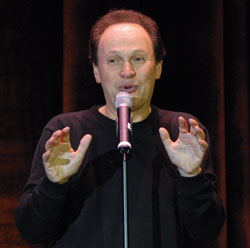
Award-winning comedian Billy Crystal headlined two side-splitting shows during Colonials Weekend Oct. 12 and 13 at the Charles E. Smith Center.
Jessica McConnell
|

New Technology Allows Rapid Cell Analysis
A new discovery by GW researchers has the potential to advance AIDS, cancer, and autism research by permitting the rapid analysis of living cells. At a media conference in February, Akos Vertes, GW professor of chemistry, biochemistry, and molecular biology, and GW graduate student Peter Nemes discussed and demonstrated their innovative laser ablation electrospray ionization technology.
The LAESI technology—part of the rapidly growing field of mass spectrometry—uses a combination of an infrared laser and electrospray to produce ions from solid or liquid surfaces. The ions then can be analyzed in a matter of seconds using a mass spectrometer,
which determines the mass of a molecule by measuring the mass-to-charge ratio of the corresponding ion.
The technique can be applied to human, animal, and plant cells, and can be used immediately in the fields of medical technology, food and drug safety, pharmacology, drug development, clinical testing, and ecology, among others. Various components of the work were supported by the National Science Foundation, the Department of Energy, and the W.M. Keck Foundation.
“Mass spectrometry is tremendously important because it has been the driving force behind the rise of a number of industries, such as pharmaceuticals and, more recently, biotechnology,” says Vertes, who is also the founder and co-director of the W.M. Keck Institute for Proteomics Technology and Applications. “We are facing a new challenge and new opportunity with the application of mass spectrometry in the medical field.”
In their laboratory, Vertes and Nemes use plant leaves to test LAESI imaging and profiling. The chemical make-up of samples can be revealed within seconds, while laser imaging can be achieved within minutes, and Vertes says their goal is to use LAESI on live organisms, which would be essential in advancing medical research.
The efforts of Vertes and his colleagues have led to innovative instrument design for the analysis of proteins, as well as better understanding of the fundamental processes involved in matrix-assisted laser desorption ionization and electrospray ionization—two essential techniques in mass spectrometry.

Students Branch Out With Eco Project
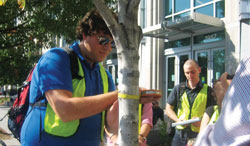
In October, students measured the diameters of tree trunks on campus for an inventory project. Geography students in an urban planning class last fall focused on the greener side of city living.
Equipped with tape measures and hand-held computers, nearly 20 eco-conscious students combed GW’s campus in October to learn more about the leafy elms and towering oaks that take root beneath the city’s concrete.
In a service-learning partnership with Casey Trees, a nonprofit organization that restores and protects the tree canopy in the nation’s capital, the class took an inventory of trees in Foggy Bottom, measuring the tree trunk diameters, the width of the canopy, and the height. Students then analyzed the tree’s health status before turning the data into a series of campus maps. With their newfound knowledge, they were able to suggest sustainable spots for new trees and to identify unhealthy existing trees that need replanting as GW continues developing its streetscape plan.
Geography Professor Lisa Benton-Short, who led the class project, coupled the in-field experience with readings and guest lecturers to explore why ecological stability is important to urban planning. Good tree canopy, or the leafy coverage that shades some buildings from the sun, can help conserve energy while also reducing carbon dioxide and making an aesthetic impact. In addition to the inventory, students were asked to give suggestions on other greening opportunities at GW; some suggested rooftop gardens, others recommended improved recycling in the dorms or the addition of waste composting facilities.
The collected data were given to GW’s Office of Real Estate, and it serves as a starting point for more in-depth assessments as GW looks to hone its 20-year plan over the next few years, says John Ralls, special adviser for communications and outreach for the Real Estate Office.
Even in the heart of the nation’s capital, where traffic snarls the streets and tall buildings overshadow sidewalks, Benton-Short says her class has learned that green living is attainable: “We’re stepping back and realizing that there is a huge environmental component to city planning that can’t be overlooked.”
—Jaime Ciavarra

Two Discoveries Explain Skeletal Remains
GW researchers investigating human origins have reported two separate, landmark discoveries this spring.
Professor Brian Richmond, working with Stony Brook University Professor William Jungers, revealed new research that suggests early human ancestors adapted to walking upright on two legs as early as 6 million years ago.
The findings, published in the March 21 issue of Science, derive from a detailed analysis of the Orrorin tugenensis fossil—a fragmentary piece of thigh bone—found eight years ago in Kenya by French researchers. Richmond and Jungers examined and compared the fossils with skeletons of modern humans, early human ancestors and relatives, and chimpanzees. They found strong evidence, including the size of the hip joint and the strength of the thigh bone, that indicates the ancestral species stood and walked on its hind limbs.
The research indicates that walking is one of the first human characteristics to appear just after the split between human and chimpanzee lineages. In another accomplishment, Richmond and GW researcher Peter Lucas are part of an international research team awarded a $2.5 million grant from The National Science Foundation to advance the understanding of skull structure and diet in human evolution.
In separate research, GW paleoanthropologists Adam Gordon, Lisa Nevell, and Bernard Wood presented new evidence that the fossil species Homo floresiensis, known as the “Hobbit,” represents a unique human lineage that diverged from our own, possibly some 1.7 million years ago.
The team’s research focused on skeletal remains, including one skull, found in Indonesia in 2003. Scientists described the species as “Hobbit” because of its small stature and brain, which was about a third the size of the modern adult brain. For their analysis, published in Proceedings of the National Academy of Sciences, Gordon, Nevell, and Wood collected and compared data on skull shape measurements of modern humans, ancient hominins of various species, and the “Hobbit.” They then considered the effects of scale and, using newly developed methods, compared the shape of the “Hobbit’s” skull with what the shape of modern human skulls would be like in individuals as small as the “Hobbit.” The team found that the “Hobbit’s” skull wasn’t shaped like that of a modern human, but rather is most similar to our possible ancestors belonging to the Homo erectus and Homo habilis species found in Africa and the Republic of Georgia.
The findings suggest that these unique hominins should be classified as their own species, as opposed to other scientific theories that the remains were of shrunken or diseased Homo sapiens. The new methods used to conduct the research also help illustrate that evolution is not a linear path.
“We’re looking at a different human lineage that split from our own…and persisted up to the time when modern humans started peopling the Americas,” says Gordon, postdoctoral research fellow with GW’s Center for the Advanced Study of Hominid Paleobiology. “That’s pretty exciting.”
—JC
Rural Culture on the Edge
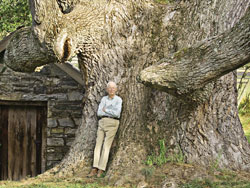 Jessica McConnell
Jessica McConnell
GW’s Virginia Campus, in partnership with Gallery 222 of the Loudoun Academy of the Arts Foundation, featured the photo essay “Rural Culture on the Edge” by Jim Hanna at an exhibition on May 8. The display, which will run through August, depicts Loudoun’s struggle to maintain its rural culture and heritage in the wake of the fastest urban development in the nation.
The man in this photo, which is part of the exhibition and was selected for the event’s invitation, is Dr. Turner Reuter, MD ’44. Reuter’s father, Frederick A. Reuter, was a 1916 graduate of GW’s medical school as well as head of the urology department and a GW trustee. Turner Reuter is the fifth generation of his family to nurture this tulip poplar, the largest tree in Loudoun County and the third largest poplar in Virginia. It is located on the Turner Reuter family Glenstone Farm.
For more information about the exhibition, contact Virginia Campus Corporate and Community Relations, 703-726-3650. |
GW Launches Five-Year Plan to Address Affordability
The GW Board of Trustees approved a five-year plan to address affordability and cost for undergraduates. Central to the plan is the University’s commitment to moderate tuition increases, improve fundraising efforts for student aid, provide additional funding for institutional grants to incoming freshmen, lower the average student debt burden upon graduation, and continue its fixed-tuition/guaranteed financial aid program.
“The affordability of higher education is a pressing concern for American families,” President Steven Knapp says. “We are committed to moderating overall costs and to preserving the benefits and predictability that our fixed-tuition program offers students and their families. Our goal is to reduce our tuition dependency as an institution by bolstering philanthropic support, especially for student aid. This shift cannot happen overnight, but this plan is a first step.”
GW’s fixed-tuition/guaranteed financial aid program, in place since 2004, locks in the undergraduate tuition rate for up to five years. As a result, returning sophomores, juniors, seniors, and fifth-year undergraduates will see no tuition increase in the 2008-09 academic year.
Tuition for freshmen entering in fall 2008 will increase 3 percent, reflecting the current rate of inflation. This price—$40,392—also will be locked in for up to five years under the fixed-tuition program.
In conjunction with fixed tuition, the University will continue its guarantee that need- and merit-based institutional financial assistance will remain at least at the levels awarded at the time of the student’s initial enrollment. If further need is demonstrated, the amount of aid could go up but it will not go down.
GW will provide $118 million in institutional financial assistance for undergraduates in 2008-09. This amount includes a $6 million increase in institutional grants for incoming freshmen. The University also offers 50 percent tuition discounts for siblings.
Another element of the plan is the University’s goal to quadruple fundraising for student aid from $10 million to $40 million annually within five years. The University also will reduce the cost of housing on 1,000 beds by approximately 19 percent this fall as a suggested option for incoming students demonstrating financial need. Depending on housing selections, overall costs (tuition, fees, housing, and food) for incoming students will range from a decrease of 0.6 percent from the current figure to an increase of 2.8 percent, the lowest increase in recent University history.
The plan also will reduce by more than 30 percent the average debt burden at the time of graduation (from $29,000 to $20,000 on average) for incoming freshmen demonstrating need. This goal will be accomplished, in part, by increasing the caps on the amount of institutional grant aid incoming students receive to up to the full amount of tuition for qualified students and by eliminating the requirement that parents fund $2,000 above the expected family contribution.
“We are encouraged to receive this thoughtful, reasoned, and comprehensive plan that will begin to moderate costs while maintaining value for students, and ultimately enhancing GW’s prestige and reputation,” says W. Russell Ramsey, BBA ’81, chairman of GW’s Board of Trustees. “Higher education is at a crossroads, and this plan sets a course in motion that will position both GW and its students for future success.”
|